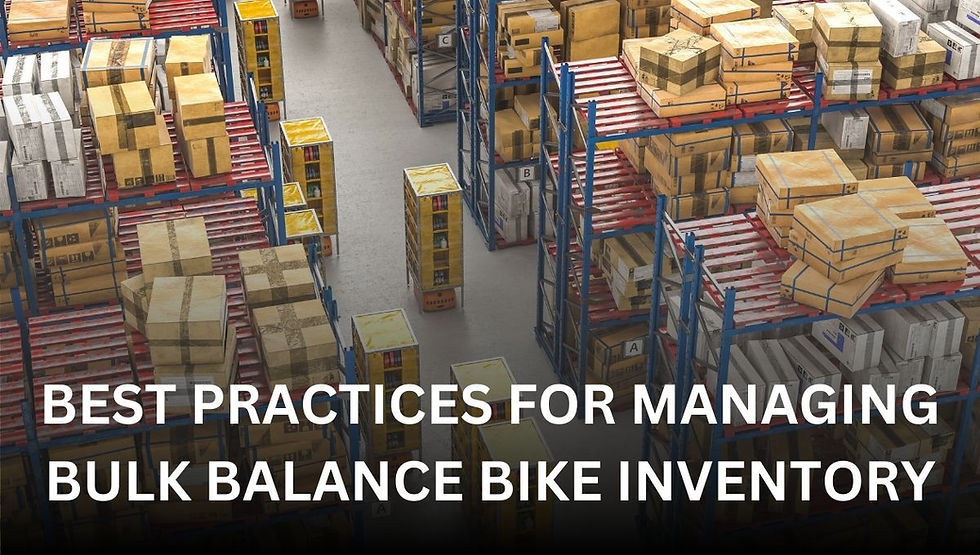Best Practices for Managing Bulk Balance Bike Inventory
- xlidaclub
- May 12
- 7 min read

Managing bulk inventory might seem like a backend task, but for businesses selling balance bikes, it can make or break profitability. Wholesale buyers, retailers, and manufacturers often face issues like overstocking, stockouts, or unsold inventory due to poor demand forecasting. These issues hurt cash flow, disrupt sales, and damage customer trust.
The good news? You can solve most of these problems with a few proven inventory management practices tailored specifically to balance bikes.
This guide will help you understand what makes balance bike inventory unique and how to streamline stock control, improve order accuracy, and meet seasonal demand with confidence. Whether you're a kids' balance bike manufacturer or a wholesale buyer, this article gives you the practical, data-backed insights you need to stay ahead.
What Makes Balance Bike Inventory Management Unique?
Balance bike inventory isn't one-size-fits-all. It involves multiple SKUs, seasonal shifts, and consumer expectations that influence both storage and fulfillment strategies.
Balance bikes often come in a variety of sizes and colors to suit different age groups and preferences. This means inventory managers must track dozens of SKUs at once, each requiring separate planning and space. Managing these SKU variations becomes more complex when you're handling bulk shipments and multiple locations. A single product line can include bikes with aluminum frames, inflatable tires, or padded seats, all affecting demand patterns.
Inventory forecasting also becomes harder when demand fluctuates around key shopping seasons. According to a report by Deloitte, retailers experience up to 40% of their annual sales during Q4, especially during holiday peaks. If you underestimate seasonal demand, you’ll likely face stockouts. Overestimate, and you’re stuck with excess bikes in your warehouse.
To stay efficient, businesses must understand the lifecycle of each SKU and plan for rotation and replenishment. This is where manufacturers like Xlida Club provide a strong advantage. They offer wholesale balance bikes with consistent supply timelines and built-in stock control assistance, simplifying the burden for retailers.
How Can You Optimize Stock Levels for Balance Bikes?
Optimizing stock levels means finding the right balance between too much and too little inventory. This avoids capital lock-up and lost sales.
Balance bike sellers often struggle with predicting how much inventory they need. One method that works well is demand-driven forecasting, using historical sales data and trends to project future needs. For example, if your spring sales show a 30% spike over winter, you can safely increase stock levels during Q1 for a smoother sales cycle.
Buffer stock is another tactic. It acts as a safety net during supplier delays or unexpected demand surges. When paired with reorder point calculations, this approach helps balance supply with customer expectations.
Some businesses also adopt just-in-time (JIT) inventory systems. While risky in high-demand periods, JIT can be useful for managing premium or slow-moving SKUs. The key is to track real-time data and regularly adjust your forecasts based on sales patterns.
Tools like NetSuite and Zoho Inventory allow integration with sales platforms to give live inventory insights. This enables better decisions on reordering, allocating stock across multiple locations, and managing bulk inventory control for balance bikes more efficiently.
Also Read: How Wholesale Balance Bikes Are Manufactured
What Tools Help with Efficient Balance Bike Inventory Tracking?
Modern inventory tracking tools eliminate guesswork and improve accuracy across your entire supply chain.
For balance bike businesses, real-time inventory software is essential. These systems track stock levels, flag reorder needs, and sync across warehouses and online storefronts. Tools like QuickBooks Commerce, Cin7, and DEAR Inventory allow barcode scanning and SKU tracking, helping avoid human errors and delays.
Automating balance bike inventory reduces the risk of double orders and missed deliveries. You can set alerts for low stock, automate PO generation, and monitor turnover rates. This means fewer manual updates and smoother operations.
Inventory turnover is another key metric. It tells you how fast stock is moving. A higher turnover ratio means you're selling efficiently, while a lower one could indicate overstocking or poor product fit. According to Shopify, top-performing retailers aim for a turnover rate of 6 to 12 times per year.
For wholesale sellers, integrating ERP systems with logistics providers improves both order visibility and shipping accuracy. You’re not just tracking stock, you’re optimizing how it's received, stored, and shipped.
Comparison of Inventory Management Tools for Balance Bikes
Tool Name | Key Features | Best For | Integration Options | Price Range |
QuickBooks Commerce | Real-time inventory tracking, order management, multi-location support | Small to mid-size bike sellers | Shopify, Amazon, WooCommerce | $$ (Mid-tier) |
Zoho Inventory | Barcode scanning, automated POs, warehouse management | Businesses with multiple SKUs | Zoho ecosystem, eBay, Etsy | $ (Budget) |
Cin7 | Omnichannel sync, forecasting, B2B tools | Growing wholesalers with complex operations | Amazon, Xero, Shopify | $$$ (Premium) |
DEAR Systems | Advanced SKU management, manufacturing modules | Balance bike manufacturers | QuickBooks, Magento, Zapier | $$$ (Premium) |
NetSuite | Enterprise-grade ERP with robust inventory and reporting tools | Large enterprises with global operations | Full ERP suite | $$$$ (Enterprise) |
How Do You Improve Order Accuracy for Bulk Balance Bike Sales?
Accurate orders prevent delays, reduce returns, and build customer trust, especially when managing wholesale volumes.
Mistakes often happen during bulk shipments because of manual entries, unclear labeling, or SKU mismanagement. To solve this, companies use digital pick-and-pack systems with barcodes and scanner verification. This eliminates shipping the wrong models or quantities.
Having a centralized dashboard also improves accuracy. You can see pending orders, confirm SKUs, and assign batch numbers. This is especially useful for companies dealing with large clients, like schools or event organizers.
Businesses like XLida Club include order verification steps in their supply chain, ensuring that each unit shipped matches the requested specification. This not only improves customer satisfaction but also saves costs on reverse logistics and reshipments.
Better accuracy translates to smoother operations and improved profit margins over time.
How Do You Handle Seasonal Demand for Balance Bikes?
Seasonal trends can cause massive demand spikes for balance bikes, especially during holidays and back-to-school campaigns.
To prepare, businesses analyze historical sales data from the last two to three years. Patterns usually emerge with higher sales from October to December, and smaller spikes in spring when outdoor activities increase. Tracking balance bike sales trends helps you predict when and how much stock you’ll need.
You can also align your marketing with these trends. Launching seasonal promotions based on inventory availability ensures that you don’t oversell items you can’t restock in time.
Inventory forecasting for balance bikes becomes even more important during these cycles. Predictive analytics tools like Inventory Planner can suggest order quantities based on sales velocity and lead times.
Warehouses also need to adjust during these peak seasons. Hiring temporary labor, expanding storage space, and updating delivery schedules are all part of a successful seasonal inventory strategy.
What Are the Best Storage Practices for Balance Bikes in Bulk?
Storing balance bikes requires smart layout planning and protection from damage.
Since bikes take up significant space, vertical racking or stackable shelving works best. You can group inventory by model or SKU to speed up picking and reduce confusion. Warehouse zoning, separating fast-moving and slow-moving SKUs, also minimizes errors and handling time.
Damage control is critical. Use padding between stacked units and climate-controlled areas to protect paint, foam parts, and rubber tires. This prevents customer complaints and lost revenue from damaged goods.
If you’re storing thousands of units, consider using fulfillment centers that offer bulk inventory control for balance bikes. These facilities already have optimized layouts, trained labor, and safety protocols in place.
How Can You Improve the Bulk Purchasing Strategy for Balance Bikes?
A strong purchasing strategy helps you buy smarter, reduce costs, and maintain a steady stock flow.
Start by analyzing past purchases to see which suppliers deliver the best balance of price, speed, and quality. Manufacturers like Xlida Club are ideal partners; they offer flexible order minimums and strong communication for scaling operations.
You can negotiate better deals by ordering during off-peak seasons when demand is lower. This also gives you time to store and prep inventory before the rush begins. Always confirm lead times and production capacity, especially when placing international orders.
If you handle large volumes, use bulk order management tools that automate POs and link to your inventory software. This ensures timely reorders and reduces errors from manual input.
Also Read: Best Wholesale Balance Bikes for Adults: Everything You Need to Know Before You Buy
How Do You Track and Manage Inventory Turnover Efficiently?
Inventory turnover shows how well you're selling products and managing capital.
Tracking this metric involves dividing your cost of goods sold by average inventory during a period. If your turnover is too low, it signals that stock is sitting too long. This ties up cash and increases storage costs.
To increase turnover, focus on fast-selling SKUs and promote slow-movers with discounts. Adjust your purchasing cycles so you only order what sells consistently. Using data from your inventory software helps you forecast better and avoid unnecessary stock.
Higher turnover also supports smoother cash flow, better supplier negotiations, and more agile inventory forecasting for balance bikes. It ensures your business isn’t just full of bikes, but full of sales.
How Can a Club Model Like XLIDA Club Streamline Inventory Management?
Leading Brands like XLida Club simplify inventory headaches by combining manufacturing, supply, and support under one roof.
They provide wholesale balance bikes in large volumes with consistent quality and predictable lead times. Retailers get access to real-time stock data, low MOQ options, and inventory restocking alerts, making it easier to manage large volumes without stress.
XLida Club also offers inventory forecasting tools and supports automation for bulk order management. This reduces the risk of human error and lets businesses scale without breaking their backend systems.
Working with a reliable balance bike manufacturer like Xlida Club gives businesses the peace of mind needed to focus on growth instead of firefighting logistics.
What Are the Most Common Mistakes in Balance Bike Inventory Management?
Even experienced businesses make mistakes. The most common ones are overstocking niche models, ignoring seasonal planning, and relying on manual tracking systems.
Many businesses also forget to track inventory turnover or set reorder alerts. As a result, they either run out of stock or hold unsold units for too long.
Failing to automate balance bike inventory is another red flag, it adds unnecessary delays and increases error rates.
By recognizing and correcting these errors, businesses can build a more responsive and profitable inventory strategy.
Conclusion
The future of inventory control lies in automation, data-driven planning, and flexible supplier partnerships. As the balance bike market continues to grow, companies that adopt smarter stock strategies will win the trust of both consumers and retailers.
If you’re managing or scaling your balance bike business, now is the time to implement these best practices. From effective tracking to seasonal planning, the right systems will keep your operations smooth and your shelves well-stocked, without the chaos.
Partnering with a supplier like XLida Club adds another layer of control and reliability. With their expertise in wholesale balance bikes and bulk inventory support, you can streamline your operations and focus on growth with confidence.




Comments